
The unification of Italy, also known as the Risorgimento, was the 19th century political and social movement that in 1861 ended in the annexation of various states of the Italian peninsula and its outlying isles to the Kingdom of Sardinia, resulting in the creation of the Kingdom of Italy. Inspired by the rebellions in the 1820s and 1830s against the outcome of the Congress of Vienna, the unification process was precipitated by the Revolutions of 1848, and reached completion in 1870 after the capture of Rome and its designation as the capital of the Kingdom of Italy.

The 1848 Revolutions in the Italian states, part of the wider Revolutions of 1848 in Europe, were organized revolts in the states of the Italian peninsula and Sicily, led by intellectuals and agitators who desired a liberal government. As Italian nationalists they sought to eliminate reactionary Austrian control. During this time, Italy was not a unified country, and was divided into many states, which, in Northern Italy, were ruled directly or indirectly by the Austrian Empire. A desire to be independent from foreign rule, and the conservative leadership of the Austrians, led Italian revolutionaries to stage revolution in order to drive out the Austrians. The revolution was led by the state of the Kingdom of Sardinia. Some uprisings in the Kingdom of Lombardy–Venetia, particularly in Milan, forced the Austrian General Radetzky to retreat to the Quadrilateral fortresses.
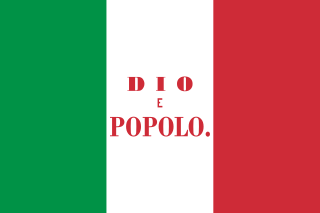
The Roman Republic was a short-lived state declared on 9 February 1849, when the government of the Papal States was temporarily replaced by a republican government due to Pope Pius IX's departure to Gaeta. The republic was led by Carlo Armellini, Giuseppe Mazzini, and Aurelio Saffi. Together they formed a triumvirate, a reflection of a form of government during the first century BC crisis of the Roman Republic.

Young Italy was an Italian political movement founded in 1831 by Giuseppe Mazzini. A few months after leaving Italy, in June 1831, Mazzini wrote a letter to King Charles Albert of Sardinia, in which he asked him to unite Italy and lead the nation. A month later, convinced that his demands did not reach the king, he founded the movement in Marseille. It would then spread out to other nations across Europe. The movement's goal was to create a united Italian republic through promoting a general insurrection in the Italian reactionary states and in the lands occupied by the Austrian Empire. Mazzini's belief was that a popular uprising would create a unified Italy. The slogan that defined the movement's aim was "Union, Strength, and Liberty". The phrase could be found in the tricolor Italian flag, which represented the country's unity.

Castro Pretorio is the 18th rione of Rome, Italy, identified by the initials R. XVIII, and it is located within the Municipio I. The rione takes its name by the ruins of the Castrum Praetorium, the barracks of the Praetorian Guard, included in the Aurelian Walls.

The Roman question was a dispute regarding the temporal power of the popes as rulers of a civil territory in the context of the Italian Risorgimento. It ended with the Lateran Pacts between King Victor Emmanuel III of Italy and Pope Pius XI in 1929.

Porta Pia was one of the northern gates in the Aurelian Walls of Rome, Italy. One of Pope Pius IV's civic improvements to the city, it is named after him. Situated at the end of a new street, the Via Pia, it was designed by Michelangelo to replace the Porta Nomentana situated several hundred meters southwards, which was closed up at the same time. Construction began in 1561 and ended in 1565, after the artist's death. A 1561 bronze commemorative medal by Gian Federico Bonzagna shows an early plan by Michelangelo, very different from his final design. The façade on the outside of the city was completed in 1869 under the Neo-Classicist design by Virginio Vespignani.
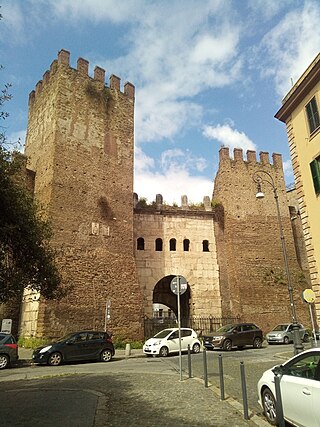
Porta Tiburtina or Porta San Lorenzo is a gate in the Aurelian Walls of Rome, Italy, through which the Via Tiburtina exits the city.
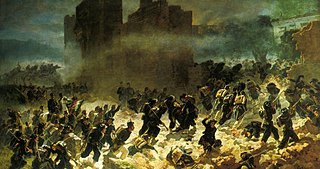
The Capture of Rome occurred on 20 September 1870, as forces of the Kingdom of Italy took control of the city and of the Papal States. After a plebiscite held on 2 October 1870, Rome was officially made capital of Italy on 3 February 1871, completing the unification of Italy (Risorgimento).
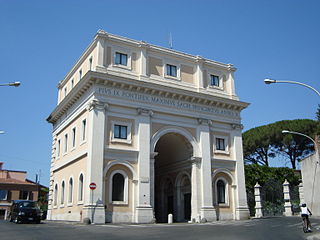
Porta San Pancrazio is one of the southern gates of the Aurelian walls in Rome, Italy.

In the Name of the Pope King is a 1977 Italian drama film written, and directed by Luigi Magni. Starring Nino Manfredi, it was not released in USA until 1986. The score was composed by Armando Trovajoli.

The Five Days of Milan was an insurrection and a major event in the Revolutionary Year of 1848 that started the First Italian War of Independence. On 18 March, a rebellion arose in the city of Milan which in five days of street fighting drove Marshal Radetzky and his Austrian soldiers from the city.

The Porta Nomentana was one of the gates in the Aurelian Walls of Rome, Italy. It is located along viale del Policlinico, around 70 m east of Porta Pia. It is now blocked and merely a boundary wall for the British Embassy.
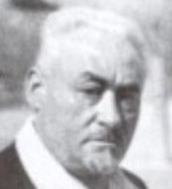
Filoteo Alberini was an Italian inventor, movie director, and one of the earliest pioneers of cinema.

The Janiculum walls are a stretch of defensive walls erected in 1643 by Pope Urban VIII as a completion of the Leonine wall and for a better protection of the area of Rome rising on the right bank of the Tiber.

Hermann Kanzler was a German general who commanded the Army of the Papal States and was the arms minister during the reign of Pope Pius IX. He led Papal forces during the Battle of Mentana against Italian troops.

The Monument to the Porta Pia Breach of Breach of Porta Pia is a memorial located on 101 Corso d'Italia, just Northwest of Porta Pia, in Rome, Italy. It commemorates the breach of the Aurelian Walls by Italian army on September 20, 1870. The Italian army quickly subdued the papal forces; the Capture of Rome leading to the annexation of nearly all of Rome and the Papal States into the Kingdom of Italy.
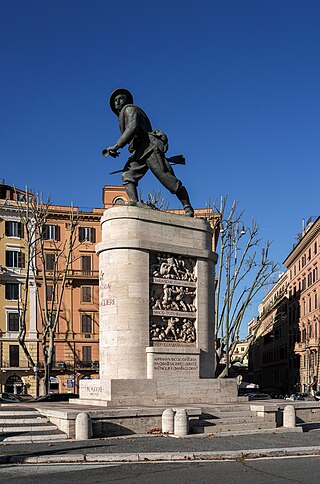
The Monument to the Bersagliere is a statuary monument located in Piazzale di Porta Pia, near the spot, where Italian soldiers were able to breach the city walls of Rome in 1870, thus leading to the integration of Rome into the Kingdom of Italy. The monument stands to the north of the gate, outside the walls. Attached to the gate buildings, designed by Michelangelo, that once represented Porta Pia, is a Museum of the History of the Bersaglieri, established here in 1921.

Alessandro Castellani was a goldsmith, antique dealer, art collector and Italian patriot belonging to the Roman Castellani family of goldsmiths and antique dealers.
Giacomo Segre was a Jewish Italian military officer during the Risorgimento.




















